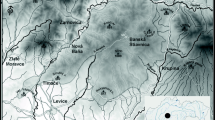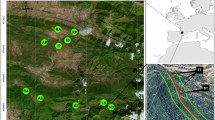Abstract
The importance of management regime on floristic variation (mosses and vascular plants) in four Danish beech forests was investigated. Sixty-four blocks were sampled, representing beech stands of different age and management types. Nineteen potential explanatory variables were recorded and tested with Monte-Carlo tests and Canonical Correspondence Analysis. In addition results were evaluated by use of Detrended Correspondence Analysis. Explanatory variables were divided into three groups; soil, microclimatic and management parameters. The amount of variation explained by each group of variables was calculated by use of variation partitioning. The group consisting of management variables explained most variation, on local as well as regional scale. Management related variables explained more variation in vegetation than any other variables together. This indicates the importance of management as determining species composition in Danish beech forests. Management related variables explained most variation on local scale. On a regional scale, soil parameters explained the major part of the variation. The results suggest that thirty years without management are sufficient to change species composition significantly, as compared to managed forests.
Similar content being viewed by others
References
Barkham, J. P. & Norris, J. M. 1970. Multivariate Procedures in an Investigation of Vegetation and Soil Relations of Two Beech Woodlands, Cotswold Hills, England. Ecology 51(4): 630–639.
Borcard, D., Legendre, P., & Drapeau, P. 1992. Partialling out the spatial component of ecological variation. Ecology 73(3): 1045–1055.
Bornebusch, C. H. 1920. Om Bedømmelse af Skovjordes Godhed ved Hjælp af Bundfloraen. Dansk Skovforenings Tidsskrift 5: 37–50.
Bornebusch, C. H. 1923. Skovbundsstudier (Disquisitions on Flora and Soil of Danish woodlands). Det Forstlige Forsøgsvæsen i Danmark 8: 1–148.
Bornebusch, C. H. 1925. Skovbundsstudier (Disquisitions on Flora and Soil of Danish woodlands. Det Forstlige Forsøgsvæsen i Danmark 8: 181–288.
Bornebusch, C. H. 1929. Danmarks skovtyper. Acta Forestalia Fennica 34(11): 5–11.
Brady, N. C. 1990. The Nature and Properties of Soils (10th. ed.). New York: Macmillan Publishing.
Cajander, A. K. 1926. Theory of Forest Types. Acta Forestalia Fennica 29: 1–107.
Collins, B. S., Dunne, K. P. & Pickett, S. T. A. 1985. Responses of Forest Herbs to Canopy Gaps. Pp. 217–233. In: S. T. A. Pickett & P. S. White (eds), The Ecology of Natural Disturbance and Patch Dynamics Academic Press, New York.
Collins, B. S. & Pickett, S. T. A. 1987. Influence of Canopy Opening on the Environment and Herb Layer in a Northern Hardwoods Forest. Vegetatio 70: 3–10.
Corley, M. F. V., Crundwell, A. C. Düll, R., Hill, M. O. and Smith, A. J. E. 1981. Mosses of Europe and the Azores; an Annotated List of Species, with Synonyms from the recent Literature. J. Bryol. 11(4): 609–689.
Diekmann, M. 1994. Decidous Forest Vegetation in Boreo-nemoral Scandinavia. Acta Phytogeographica Suecica 80: 1–107.
Edwards, M. E. 1986. Disturbance Histories of Four Snowdonian Woodlands and Their Relation to Atlantic Bryophyte Distributions. Biol. Cons. 37: 301–320.
Ellenberg, H. 1963. Vegetation Mitteleuropas mit den Alpen. Eugen Ulmer, Stuttgart.
Evans, M. N. & Barkham, J. P. 1992. Coppicing and Natural Disturbance in TemperateWoodlands – a Review. Pp. 79–98. In: G. P. Buckley (ed.), Ecology and Management of Coppice Woodlands. Chapman & Hall, London.
Falinski, J. B. 1986. Vegetation Dynamics in Temperate Lowland Primeval Forest. Ecological Studies in Bialowieza Forest. In Werger, M. J. A. (series editor), Geobotany 8.
Gauch, H. G. Jr. 1982. Multivariate Analysis in Community Ecology. Cambridge University Press, Cambridge.
Geiger, R. 1966. Problems in Forest Meteorology. Pp. 298–369. In: R. Geiger (ed.), The Climate near the Ground. Harvard University Press, Harvard.
GEUS (Geologiske Undersøgelser), 1996. Jordartskort. 1: 25.000.
Grime, J. P., Hodgson, J. G. & Hunt, R. 1988. Comparative Plant Ecology, A Funtional Approach to Common British Species. Unwin Hyman, London.
Gustafsson, L. & Hallingbäck, Y. 1988. Bryophytes Flora and Vegetation of Managed and Virgin Coniferous Forest in South-West Sweden. Biol. Cons. 44: 283–300.
Hansen, K. (ed.) 1981. Dansk feltflora. Gyldendal, Copenhagen.
Harper, J. H. 1977. Population Biology of Plants. Academic Press, New York.
Henriksen, H. A. 1988. Skoven og dens dyrkning. Nyt Nordisk Forlag, Copenhagen.
Hermy, M. & Stieperaere, H. 1981. An Indirect Gradient Analysis of the Ecological Relationships between Ancient and Recent Riverine Woodlands to the South of Bruges (Flanders, Belgium). Vegetatio 44: 43–49.
Hill, M. O. & Gauch, Jr. H. G. 1980. Detrended Correspondence Analysis: an Improved Ordination Technique. Vegetatio 42: 47–58.
Hutchison, B. A. & Matt, D. R. 1977. The Distribution of Solar Microclimatic within a Deciduous Forest. Ecol. Monographs 47: 185–207.
Jahn, G. 1991. Temperate Deciduous Forests of Europe. Pp. 377–502. In: Röhrig B. & Ulrich, E. (eds), Temperate Deciduous Forests. Elsevier, Amsterdam.
Jongman, R. H. G., ter Braak, C. J. F., & Van Tongeren, O. F. R. 1987. Data Analysis in Community and Landscape Ecology. Pudoc Wageningen, Wageningen.
Jonsson, B. G. & Esseen, P. A. 1990. Treefall Disturbance Maintains High Bryophyte Diversity in a Boreal Spruce Forest. J. Ecol. 78: 924–936.
Kirby, K. J. 1988. Changes in the Ground Flora under Plantations on Ancient Woodland Sites. Forestry 61(4): 317–338.
Køie, M. 1979. Planternes Levevilkår. Pp. 151–246. In: Nørrevang, A. & Lundø, J. (eds) Danmarks Natur. Vol 2. Politikens forlag, Copenhagen.
Køie, M. 1989. Forest and scrub. Opera Bot. 96: 63–67.
Leps, J. & Hadincova, V. 1992. How Reliable are our Vegetation Analyses? J. Veg. Sci. 3(1): 119–124.
Lesica, P., McCune, B., Cooper, S.V., Hong, W. S. 1991. Differences in lichen and bryophyte communities between old-growth and managed second-growth forests in the Swan Valley, Montana. Can. J. Bot. 69: 1745–1755.
Lewinsky, J. 1974. The family Plagiotheciaceae in Denmark. Lindbergia 2: 185–217.
Matlack, G. R. 1994. Vegetation dynamics of the forest edge – trends in space and successional time. J. Ecol. 82: 113–123.
Mattews, J. D. 1991. Silvicultural Systems Oxford University Press.
Mayer, H. 1984. Wälder Europas. Gustav Fisher Verlag, Stuttgart.
McNeely, J. A., Gadgil, M., Leveque, C., Padoch, C. & Redford, K. 1995. Human Influence on Biodiversity. In: Heywood, V. H. (ed.), Global Biodiversity Assessment. U.N. Environmental Program.
Miller, K., Allegretti, M. H., Johnson, N. & Jonsson, B. 1995. Measures for Biodiversity and Sustainable Use of its Components. In: Heywood, V. H. (ed.), Global Biodiversity Assessment. U.N. Environmental Program.
Mucina, L. & van der Maarel, E. 1989. Twenty Years of Numerical Syntaxonomy. Vegetatio 81: 1–15.
Møller, P. F. 1988. Naturskove i statsskovene. (Intern rapport. No. 4). Danmarks Geologiske Undersøgelser.
Palmer, M. W. & Dixon, P. M. 1990. Small-scale Environmental Heterogeneity and the Analysis of Species Distributions along Gradients. J. Veg. Sci. 1: 57–65.
Palmer, M. W. 1990. Spatial Scale and Pattern of Species-Environment Relationship in Hardwood Forest of the North Carolina Piedmont. Coenoses 5(2): 79–87.
Palmer, M. W. 1993. Putting Things in Even Better Order: the Advantages of Canonical Correspondence Analysis. Ecology 74(8): 2215–2230.
Peterken, G. F. 1974. A Method for Assessing Woodland Flora for Conservation using Indicator Species. Biol. Cons. 6(4): 239–245.
Peterken, G. F. 1981. Woodland Conservation and Management. Chapman and Hall, New York.
Peterken, G. F. 1996. Natural Woodland, Ecology and Conservation in Northern Temperate Regions. Cambridge University Press, Cambridge, 522 pp.
Peterken, G. F. & Game, M. 1984. Historical Factors Affecting the Number and Distribution of Vascular Plant Species in the Woodlands of Central Lincolnshire. J. Ecol. 72: 155–182.
Petersen, P. M. 1994. Flora, Vegetation and Soil in Broad-leaved Ancient and PlantedWoodland and Scrub on Røsnæs, Denmark. Nord. J. Bot. 14(6): 693–709.
Rackham, O. 1980. Ancient Woodland, its History, Vegetation and uses in England. Edward Arnold, London.
Reader, R. J. & Bricker, B. D. 1992. Response of Five Deciduous Forest Herbs to Partial Canopy Removal and Patch Size. Am. Midland Nat. 127: 149–157.
Reed, R. A. Peet, R. K., Palmer, M. W. & White, P. S. 1993. Scale Dependence of Vegetation-Environment Correlations: A Case Study of a North Carolina Piedmont Woodland. J. Veg. Sci. 4: 329–340.
Runkle, J. R. 1985. Disturbance Regimes in Temperate Forests. Pp. 17–33. In: S. T. A. Pickett & P. S. White (eds.), The Ecology of Natural Disturbance and Patch Dynamics Academic Press, Inc, New York.
Röhrig, E. 1991. Vegetation Structure and Forest Succession. Pp. 35–49. In: E. Röhrig & B. Ulrich (eds.), Temperate Deciduous Forests Elsevier, Amsterdam.
Simmons, E. A. & Buckley G. P. 1992. Ground vegetation under planted mixtures of trees. Pp. 211–231. In: Cannell M. G. R. et al. (eds), The Ecology of Mixed-species Stands of Trees. Blackwell Scientific Publications, Oxford.
Shmida, A. & Wilson, M. V. 1985. Biological determinants of species diversity. J. Biog. 12: 1–20.
Smilauer, P. 1992. CANODRAW User's guide, version 3.0. Ithaca, Microcomputer Power, New York.
Sokal, R. R. & Rohlf, F. J. 1995. Biometry (third ed.). W.H. Freeman and Company, New York.
Sydes, C. & Grime, J. P. 1981a. Effect of Tree Leaf Litter on Herbaceous Vegetation in Decidous Woodland I. J. Ecol. 69: 237–248.
Sydes, C. & Grime, J. P. 1981b. Effect of Tree Leaf Litter on Herbaceous Vegetation in Deciduous Woodland II. J. Ecol. 69: 249–262.
Söderström, L. 1988. The Occurence of Epixylic Bryophyte and Lichen Species in an Old Natural and a Managed Forest Stand in Northeast Sweden. Biol. Cons. 45: 169–178.
ter Braak, C. J. F. 1988. CANOCO – a FORTRAN Program for Canonical Community Ordination by (partial) (detrended) (canonical) Correspondence Analysis, Principal Component Analysis and Redundancy Analysis. Version 2.1. Agricultural Mathematics Group, Wageningen.
ter Braak, C. J. F. 1990. Update notes: CANOCO version 3.10.
ter Braak, C. J. F. 1991. CANOCO – a FORTRAN Program for Canonical Community Ordination by Partial Detrended Canonical Correspondence Analysis, Principal Component Analysis and Redundancy Analysis. Version 3.12. Agricultural Mathematics Group, Wageningen.
Volpers, T. 1989. Changes inMicroclimate andVegetaion after Thinning in a Montane Virgin Forest. Phytocoenologia 17(1): 71–104.
Warming, E. 1919. Skovene. Botanisk Tidsskrift 35(3): 1–653.
Wittig, R., & Neite, H. 1985. Acid Indicators around the Trunk Base of Fagus sylvatica in Limestone and Loess Beechwoods: Distribution Pattern and Phytosociological Problems. Vegetatio 64: 113–119.
Whitney, N. N. & Foster, D. R. 1988. Overstorey Composition and Age as Determinants of the Understorey Flora of Woods of Central New England. J. Ecol. 76: 867–876.
Økland, R. H. 1990. Vegetation Ecology: Theory, Methods and Applications with Reference to Fennoscandia. Sommerfeltia Supplement 1: 1–233.
Økland, R. H., & Eilertsen, O. 1994. Canonical Correspondence Analysis with Variation Partitioning: some Comments and an Application. J. Veg. Sci. 5: 117–126.
Økland, T. 1988. An Ecological Approach to the Investigation of a Beech Forest in Vestfold, SE Norway. Nord. J. Bot. 8(4): 375–407.
Author information
Authors and Affiliations
Rights and permissions
About this article
Cite this article
Aude, E., Lawesson, J.E. Vegetation in Danish beech forests: the importance of soil, microclimate and management factors, evaluated by variation partitioning. Plant Ecology 134, 53–65 (1998). https://doi.org/10.1023/A:1009720206762
Issue Date:
DOI: https://doi.org/10.1023/A:1009720206762




